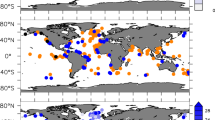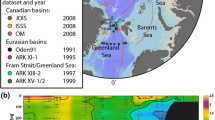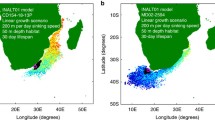Abstract
To verify the actual usefulness of time-dependent tracer dating techniques in the ocean, we simultaneously obtained two cross sections of sulfur hexafluoride (SF6) and chlrofluoromethanes (CFC-11, trichlorofluoromethane; CFC-12, dichloro-difluromethane; CFC-113, trichlorotrifluoroethane) in the western North Pacific in 1998. The vertical distribution patterns of SF6 and CFC-113 were similar in shape to those of CFC-11 and CFC-12. Maximum penetration depths of SF6 and CFC-113 remained around 800 m in the subpolar region and 400 m in the tropical region, while the maximum penetration depths of CFC-11 and CFC-12 were still found below 1000 m depth. We also found all maximum contents of these tracers around 26.6−26.8σθ with a gradual decrease southward. This suggested that a new subsurface water mass in the subpolar region spread out over the entire North Pacific, which agrees closely with previous studies based on the salinity minimum. Moreover, we compared the tracer ages (the elapsed period of a water mass from when the water mass left from the ocean surface) using ten time-dependent tracer dating techniques, CFC-11, CFC-12, CFC-113, SF6, CFC-11/CFC-12, CFC-113/CFC-11, CFC-113/CFC-12, SF6/CFC-11, SF6/CFC-12 and SF6/CFC-113. This quantitative evaluation of multiple tracer dating techniques in the ocean was the first confirmation of its usefulness based on the observational data on the ocean basin-wide scale. We conclude that SF6/CFC-11, SF6/CFC-12, SF6/CFC-113 and SF6 dating techniques would be the most promising tools for determining the age of water mass not only just for the past several decades but for the future, too.
Similar content being viewed by others
References
Bu, X. and M. J. Warner (1995): Solubility of chlorofluorocarbon 113 in water and seawater. Deep-Sea Res., 42, 1151-1161.
Bullister, J. L. and R. F. Weiss (1988): Determination of CCl3F and CCl2F2 in seawater and air. Deep-Sea Res., 35, 839-853.
Bullister, J. L., D. P. Wisegarver and F. A. Menzia (2002): The solubility of sulfur hexafluoride in water and seawater. Deep-Sea Res., 49, 175–187.
Doney, S. C. and J. L. Bullister (1992): A chlorofluorocarbon section in the eastern North Atlantic. Deep-Sea Res., 39, 1857–1883.
Doney, S. C., W. J. Jenkins and J. L. Bullister (1997): A comparison of ocean tracer dating techniques on a meridional section in the eastern North Atlantic. Deep-Sea Res., 44, 603–626.
Emerson, S., S. Mecking and J. Abell (2001): The biological pump in the subtropical North Pacific: nutrient sources, Redfield ratios, and recent changes. Global Biogeochem. Cycles, 15, 535–554.
Fine, R. A., J. L. Reid and H. G. Ostlund (1981): Circulation of tritium in the Pacific Ocean. J. Phys. Oceanogr., 11, 3–14.
Gruber, N., J. L. Sarmiento and T. F. Stocker (1996): An improved method for detecting anthropogenic CO2 in the oceans. Global Biogeochem. Cycles, 10, 809–837.
Law, C. S. and A. J. Watson (2001): Determination of Persian Gulf Water transport and oxygen utilization rates using SF6 as a novel transient tracer. Geophys. Res. Lett., 28, 815-818.
Law, C. S., A. J. Watson and M. I. Liddicoat (1994): Automated vacuum analysis of sulfur hexafluoride in seawater: derivation of the atmospheric trend (1970-1993) and potential as transient tracer. Mar. Chem., 48, 57–69.
Ledwell, J. R. and A. J. Watson (1991): The Santa Monica Basin tracer experiment: a study of diapycnal and isopycnal mixing. J. Geophys. Res., 96, 8695–8718.
Maiss, M. and C. A. M. Brenninkmeijer (1998): Atmospheric SF6: trends, sources, and prospects. Environ. Sci. Tech., 32, 3077–3086.
Ono, T., Y. W. Watanabe and S. Watanabe (2000): Recent increase of DIC in the western North Pacific. Mar. Chem., 72, 317–328.
Ono, T., T. Midorikawa, Y. W. Watanabe, K. Tadokoro and T. Saino (2001): Temporal increase of phosphate and apparent oxygen utilization in the subsurface waters of western subarctic Pacific from 1968 and 1998. Geophys. Res. Lett., 28, 3285–3288.
Ravishankara, A., S. Solomon and A. A. Turnipseed (1993): Atmospheric lifetimes of long-lived halogenated species. Nature, 259, 194–199.
Reid, J. L. (1965): Intermediate waters of the Pacific Ocean. Dr. Sci. Thesis, Johns Hopkins University.
Smethie, W. M. J., D. W. Chipman and K. P. Koltermann (1988): Chlorofluoromethanes in the Arctic Mediterranean seas: evidence for formation of bottom water in the Eurasian Basin and deep-water exchange through Fram Strait. Deep-Sea Res., 35, 347–369.
Tokieda, T., S. Watanabe and S. Tsunogai (1996): Chlorofluorocarbons in the western North Pacific in 1993 and formation of North Pacific Intermediate Water. J. Oceanogr., 52, 478–490.
Upstill-Goddard, R. C., A. J. Watson, P. S. Liss and M. I. Liddicoat (1990): Gas transfer velocities in lakes measured with SF6. Tellus, 42B, 364–377.
VanScoy, K. M., D. B. Olson and R. A. Fine (1991): Ventilation of North Pacific Intermediate Water: the role of the Alaskan Gyre. J. Geophys. Res., 96, 16801–16810.
Walker, S. J., R. F. Weiss and P. K. Salameh (2000): Reconstructed histories of the annual mean atmospheric mole fractions for the halocarbons CFC11, CFC12, CFC113 and carbon tetrachloride. J. Geophys. Res., 105, 14285–14296.
Wanninkhof, R., J. R. Ledwell and W. S. Broecker (1985): Gas exchange-wind speed relation measured with sulfur hexafluoride on lake. Science, 227, 1224–1226.
Warner, M. J. and R. F. Weiss (1985): Solubility of chlorofluorocarbons 11 and 12 in water and seawater. Deep-Sea Res., 32, 1485–1497.
Warner, M. J., J. L. Bullister, D. P. Wisegarver, R. H. Gammon and R. F. Weiss (1996): Basin-wide distribution of chlorofluorocarbons CFC-11 and CFC-12 in the North Pacific: 1985-1989. J. Geophys. Res., 101, 20525–20542.
Watanabe, Y. W., K. Harada and K. Ishikawa (1994): Chrolofluorocarbons in the central North Pacific and southward spreading time of North Pacific Intermediate Water. J. Geophys. Res., 99, 25195–25213.
Watanabe, Y. W., A. Ishida, M. Tamaki, K. Okuda and M. Fukasawa (1997): Water column inventories of CFCs and production rate of intermediate water in the North Pacific. Deep-Sea Res., 44, 1091–1104.
Watanabe, Y. W., T. Ono and A. Shimamoto (2000): Increase in the uptake rate of oceanic anthropogenic carbon in the North Pacific determined by CFC age. Mar. Chem., 72, 295–315.
Watanabe, Y. W., T. Ono, A. Shimamoto, T. Sugimoto, M. Wakita and S. Watanabe (2001): Possibility of a reduction in the formation rate of the subsurface water in the North Pacific. Geophys. Res. Lett., 28, 3285–3288.
Watson, A. J. and M. I. Liddicoat (1985): Recent history of atmospheric tracer gas concentrations deduced from measurements in the deep sea: application to sulfur hexafluoride and carbon tetrachloride. Atmos. Environ., 19, 1477–1484.
Watson, A. J., R. C. Upstill-Goddard and P. S. Liss (1991): Airsea gas exchange in rough and stormy seas measured by a dual-tracer technique. Nature, 349, 145–147.
Wisegarver, D. P. and R. H. Gammon (1988): A new transient tracer: measured vertical distribution of F-113 in the North Pacific subarctic gyre. Geophys. Res. Lett., 15, 188–191.
WOCE (1999): WOCE Hydrographic Program Office. http:// whpo.ucsd.edu/index.htm
Yamanaka, G., Y. Kitamura and M. Endo (1998): Formation of North Pacific Intermediate Water in Meteorological Research Institute ocean general circulation model 2: transient tracer experiments. J. Geophys. Res., 103, 30905–30921.
Author information
Authors and Affiliations
Rights and permissions
About this article
Cite this article
Watanabe, Y.W., Shimamoto, A. & Ono, T. Comparison of Time-Dependent Tracer Ages in the Western North Pacific: Oceanic Background Levels of (SF6, CFC-11, CFC-12 and CFC-113. Journal of Oceanography 59, 719–729 (2003). https://doi.org/10.1023/B:JOCE.0000009600.12070.1a
Issue Date:
DOI: https://doi.org/10.1023/B:JOCE.0000009600.12070.1a




